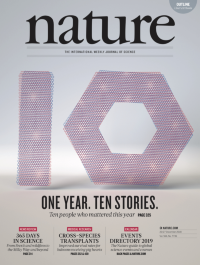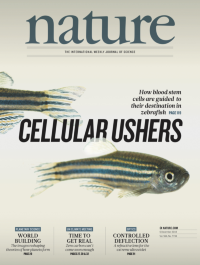Volume 564
-
No. 7736 20 December 2018
One year. Ten stories.As 2018 draws to a close, we once again select Nature’s 10—ten people who made a difference in research this year. The cover design highlights advances in studies of atom-thick materials with unusual properties. The image represents two graphene sheets offset by a ‘magic’ angle, an arrangement that can behave as a superconductor in certain conditions.
-
No. 7735 13 December 2018
Quantum networkingThe ability to use quantum keys to encrypt communications has matured sufficiently to be used in the real world. However, to date, such quantum key distribution has been limited to communication between just two parties. In this week’s issue, Sören Wengerowsky and his colleagues demonstrate a fully connected quantum network architecture in which one source of entangled photons distributes quantum states to four different users and allows each of them to generate a secret key for secure communication. The researchers say the network will readily scale to accommodate a much larger number of users because no adaptations of the entanglement source are required to add participants. In addition, the network operates in the telecom band and does not require active switching elements, which means it could function at high quantum communication speeds.
Nature Outlook
-
No. 7734 6 December 2018
Cellular ushersIn vertebrates, haematopoietic stem and progenitor cells (HSPCs) act as the source for all of the blood cells needed over an organism’s lifespan. HSPCs emerge from endothelial cells in the dorsal aorta of developing embryos and then migrate to dedicated niches where they are stored ready to generate blood cells. In this week’s issue, Weijun Pan and colleagues shed light on the mechanism by which HSPCs are shuttled to their destination. Working with zebrafish embryos, the researchers found that macrophage-like cells act as ushers, guiding the HSPCs to their destination and helping to retain them in their niche microenvironments.



